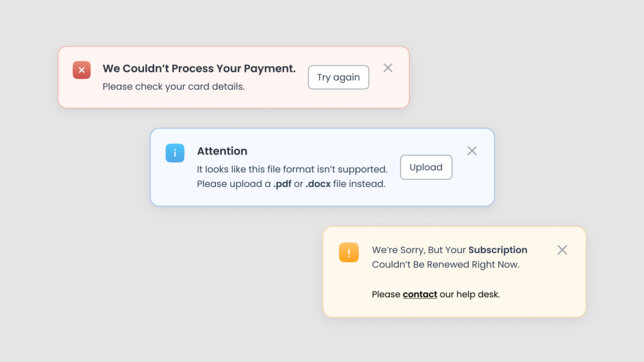
Szymon Rodzeń
-
Jul 11, 2024
-
15 min read
The tone of voice vs voice and tone – what’s the difference?
Sometimes, terms like “voice”, “tone”, and “tone of voice” are used interchangeably. While it’s true that they’re interconnected (since they all shape how a brand communicates with its audience), there are a couple of important distinctions. It’s best to know them beforehand before we dig deeper into the topic.
The tone of voice in marketing
For starters, the term tone of voice is most frequently used in marketing. Its primary aim is to reflect the brand’s personality through various channels such as advertisements, social media, and promotional materials. It adapts to the current campaign goals and diverse audience segments.
Moreover, tone of voice often focuses on emotional appeal to drive engagement and, perhaps most importantly, conversion. A well-implemented tone of voice builds a memorable brand identity and connects with its audience. It evokes desired emotions and persuades the audience to take specific actions.
Check out our dedicated article on tone of voice and its dos and don'ts to learn more.
Tone and voice in UX writing
On the other hand, UX writing professionals prefer to separate voice from tone more firmly. In this context, voice refers to a stable element of the brand’s personality.
Tone, on the other hand, is highly adaptable. It modulates the communication style to suit various situations, such as success and error messages, onboarding, navigation and notifications. While some of these contexts allow for a more casual approach, others demand writing a specific, direct message. The tone is based on the user’s emotional state during a specific process they’re engaging with.
Incorporating voice and tone facilitates smooth user interactions and enhances the digital product’s usability. It puts the user in the centre, ensuring an intuitive experience without causing any friction.
Strategic alignment of UX writing and marketing
Although marketing professionals' and UX writers' approaches differ, the best brands strategically align them to create a cohesive experience. UX insights can inform marketing strategies, particularly in understanding user preferences. And vice versa – marketing campaigns can influence UX writing by shaping initial perceptions of the product.
Characteristics of voice in UX
Voice is sometimes compared to a brand’s DNA. It’s an unchangeable, expressive personality that encapsulates all the brand's distinctive qualities. Voice can be seen as a persona, a fictional character with the goal of expressing specific values.
Those values can be put on spectrums, and the most widely used model proposes four characteristics: formality, humour, respectfulness, and enthusiasm. Most voices lie somewhere between being:
- casual and formal,
- serious and funny,
- irreverent and respectful,
- enthusiastic and factual.
Identifying where your brand’s voice lies on those four dimensions is the first exercise for developing a concise voice for all your UX writing purposes.
Defining the voice
A brand’s voice is mostly determined by its identity and target audience. To help it stand out, it’s best to make it unique. But, what’s more important, the voice needs to be consistent. Users need to feel like they’re interacting with the same entity across different contexts.
So, to create your brand’s voice, it’s best to answer a couple of questions first:
- What core values and personality traits should the brand embody?
- Who is your target audience, and what communication style resonates with them?
- What type of language aligns best with your brand’s mission and vision?
- How do you want your audience to feel while they interact with your brand?
- What sets your brand apart from the competitors?
The next step is ensuring the voice remains the same across various touchpoints. That’s where the style guide comes into play. Write detailed guidelines, provide examples of dos and don’ts and include sample phrases for various contexts. But, to write the best style guide possible, you’ll need a firm understanding of another of its key ingredients: the tone.
To learn about the details of a style guide, visit our Digital 101 page with a dedicated article.
Understanding the tone in UX writing
To properly understand this part of the article, we encourage you to check out our article on "What is UX writing? Rules of effective UX writing".
Now, let's get back to the tone in UX writing. It heavily depends on the context and situation. If the voice is a character, the tone is their mood. The tone reflects the attitudes and emotions appropriate for a specific moment. It sympathises with the user, understanding their state of mind at every step of their journey.
To put things simply, the tone is:
- context-dependent: it changes based on the situation,
- emotionally resonant: it considers the user’s emotional state and positively influences it,
- flexible: it shifts without altering the brand’s overall personality encapsulated in its voice.
Error messages illustrated
Empathy is key to creating an effective tone of UX writing. This principle can be illustrated with a clear example of error messages. Even though this approach is still prevalent in some corners of the Web, error messages aren’t a place to incorporate humour. It’s best to keep them simple and get straight to the point, telling the user precisely what went wrong and why. Inform them if they can do anything to mitigate the error, and if not – state when it will be fixed.
While your brand’s tone may be light-hearted and informal, encountering an error is a dire situation requiring a reassuring response to show the user they are being taken care of. Consider how the following examples utilise different tones while still offering a clear explanation:

3 examples of effective success messages
Success messages, on the other hand, are more suited for some chatter and personality. The user might feel happy and accomplished upon completing a process, and you can smoothly capitalise on those emotions. Siding with the user can invoke a sense of common ground between them and your brand:

Challenges in maintaining voice and tone
Having a comprehensive style guide with impeccable voice descriptions and tone examples is one thing. Being able to maintain the voice and tone across various touchpoints is another. It’s especially tough when your brand grows and diversifies, but that’s not the only source of obstacles. Here are the most common difficulties:
Alignment across different teams
Each department, from marketing and customer service to product development and UX writing, might interpret the brand’s voice and tone differently. This misalignment can lead to further mishaps, fragmented communication, and a feeling of a disjointed and inconsistent brand personality. To mitigate this issue, ensure every interested party knows the guidelines by heart, and conduct regular training. Organise workshops to foster the ability to apply the brand’s voice and tone consistently. You can even go as far as incorporating scenarios and role-playing exercises based on a real-life context and use cases.
Scaling content production
As many brands inevitably ramp up content production, preserving a unified voice and tone becomes increasingly tricky—more so if third-party content creators and automated tools are involved. To relieve this struggle, try to implement a thorough review process. Check every piece of content before publication and use dedicated roles responsible for overseeing the voice and tone. Build a repository with approved content examples that writers can refer to.
Adapting voice and tone for diverse audiences
If your brand aims for a broad market, it will surely resonate differently with diverse cultural and demographic audiences. What works in one group may not be effective in another, so maintaining the core brand identity might be challenging. One way of knowing what your audience thinks is to conduct UX research. It provides an invaluable insight into the preferences and sensitivities of different user segments. You can then conduct A/B tests to experiment with different approaches to determine which one is the best received.
Keeping the voice and tone relevant over time
Industries and brands change over time, so the voice and tone should also evolve to keep up. User expectations and trends can shift rapidly, and responding to those changes is crucial if you want your brand to stay relevant. Staying in touch with recent communication standards, monitoring user behaviour, and following industry leaders are crucial to ensure that your voice and tone remain up to date. You can also gather frequent feedback from your digital product’s users to learn how they perceive your brand. If their perspective no longer aligns with your goals, it’s time to make some necessary adjustments.
Ensuring tone appropriateness in sensitive situations
We can’t emphasise this enough—context is (almost) everything. Balancing appropriateness in different contexts to support various interactions requires careful consideration. If your tone and voice are guided by empathy and clarity, you have nothing to fear. But beware—crises happen, and you must be prepared for any sensitive scenario. Striking the right tone in those difficult situations is particularly challenging, but it’s also crucial for maintaining user trust and brand reputation. Try establishing a review process in advance to facilitate the quick creation of meaningful messages in unforeseen circumstances, such as unexpected global errors or third-party service shortages.
Voice and tone – a coordinated effort
Mastering voice and tone in UX writing is crucial for creating an engaging, empathetic, user-centric and effective design. By understanding the nuances and implementing them strategically, you can also significantly influence your brand’s perception.
Achieving and, more importantly, maintaining a coherent voice and tone demands a coordinated effort across your organisation. It includes ongoing training and robust strategy development to handle the inherent complexities and dynamic nature of communicating with users. At some point, it’s worth considering creating a voice and tone task force dedicated solely to maintaining its consistency and relevancy.
To guide improvements, seek feedback from both users and internal teams. Their combined insights will greatly help you refine your approach and ensure your brand’s voice and tone resonate effectively with its audience for many years to come.



















